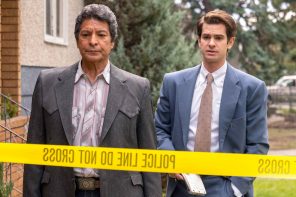Now that the widely-reviewed film 8: The Mormon Proposition has left the film festival circuit and is available through on-demand cable—with some rumors of technical difficulties in the Salt Lake / Provo areas—reaction is filtering back from Mormon viewers of the film.
LDS Church spokespeople have dismissed the film as blatantly false.
But what I’m hearing from a number of Mormons deeply familiar with the Proposition 8 campaign is that the film gets it mostly right. [See also Holly Welker’s review here. – Eds] Some take exception to editing choices that sequence events out of context for dramatic effect; others wish that the filmmakers had not been so cartoonish in their depictions of anti-gay-marriage standpoints, using only notorious bigots like Utah Representative Chris Buttars.
But most of the Mormon folks I’m hearing from agree: to see this film is to know what we on the inside saw unfolding all around us during election season 2008.
And since then, we’ve seen the costs to our community of claiming to work in “coalition” with others while in fact shouldering an incredibly disproportionate share of the work and fundraising.
The old Mormon pioneer hymn celebrates the virtue of “putting our shoulders to the wheel.” Hard work is a Mormon tradition of which I am proud.
Insider double-talk is not. For when institutional ecclesiastical resources were used to leverage “voluntary” and “grassroots” participation from Church members, the stage was set for the kind of dramas of “revelation” and “exposé” the Church now finds itself beset with—played out on movie and television screens across the country.
For every action there is an equal and opposite reaction. What you sow you shall reap. No matter how carefully Mormon political consultants (some of them paid handsomely by Church members’ donations) tried to script a Mormon “grassroots” relationship to the Yes on 8 campaign, talking themselves and the members of their insular world into the legitimacy of these arrangements, it was naive and foolish to think that such a campaign could be conducted without significant consequences.
One of these consequences is that the Church has now branded itself as the leading anti-gay-rights religion in the country. That’s an expensive bit of turf to hold in an unsustainable legal and political fight. Every day, I read news stories from across the country about Mormons. And let me tell you, this movie alone has gotten ten times more coverage than the Church’s incredible humanitarian efforts in Haiti and the greening of its chapels combined.
Perhaps it is because the leveraging of Mormon “grassroots” participation created an environment of double-talk and secrecy that hearkens back to the polygamy days of the late nineteenth century and reaffirms some of the oldest and least favorable public stereotypes of Mormons as an insular, secretive, manipulative people.
During the campaign season, many of us who were Mormon and supported marriage equality found ourselves in the otherworldly situation of trying to communicate to outsiders the magnitude of what we saw happening inside our Church, only to be met—for the most part—with disinterest or disbelief, or a consistent underestimation of Mormon organizational capacity and discipline.
Well-meaning, politically savvy, liberal friends took one look at my wild, puffy eyes during fall 2008 and would say—trying to be comforting—“I know, I know, the evangelicals are at it too” or “don’t worry, there just aren’t that many of you Mormons in California.”
Ignorance.
It is precisely this kind of insularity and ignorance that a progressive public conversation about religion must confront and, finally, demolish.




